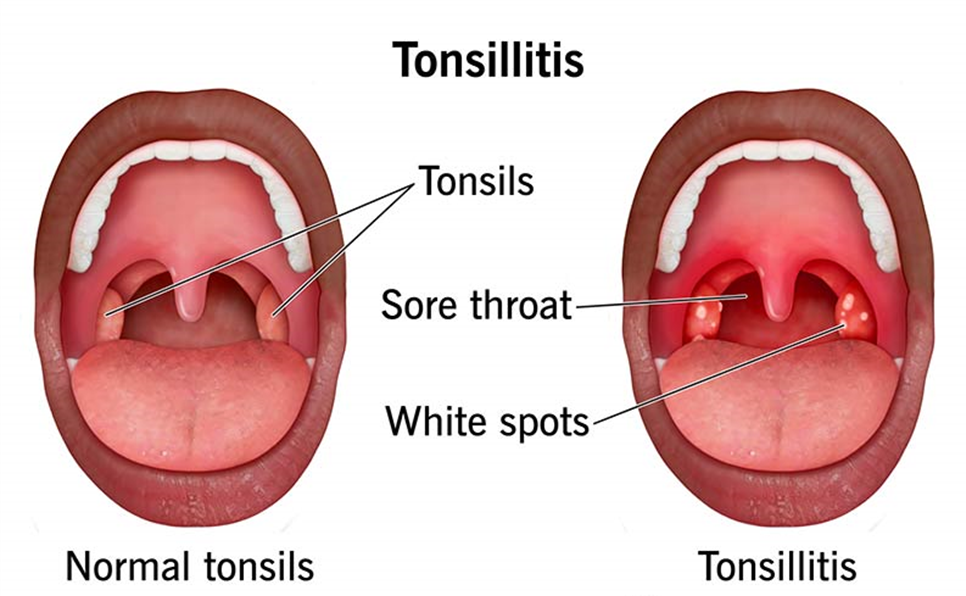The nurse is collecting data on a child with a diagnosis of tonsillitis. Which clinical manifestation would likely have been noted in the child with this diagnosis?
Inability to make audible voice sounds
Erythema of the pharynx
Bark-like cough
Hoarseness
The Correct Answer is B
A. Inability to make audible voice sounds:
This symptom is more indicative of conditions affecting the vocal cords or larynx, such as laryngitis. Tonsillitis primarily involves inflammation of the tonsils and may not directly impact the ability to make audible voice sounds.
B. Erythema of the pharynx:
Erythema (redness) of the pharynx is a common manifestation of tonsillitis. Inflammation of the tonsils and surrounding areas can lead to redness and swelling in the throat.
C. Bark-like cough:
A bark-like cough is often associated with croup, which involves inflammation of the larynx and trachea, not the tonsils. It is a distinct condition from tonsillitis.
D. Hoarseness:
Hoarseness can be a symptom of various conditions affecting the vocal cords or larynx, but it is not a typical manifestation of tonsillitis. Tonsillitis is more commonly associated with sore throat, difficulty swallowing, and erythema of the pharynx.

Nursing Test Bank
Naxlex Comprehensive Predictor Exams
Related Questions
Correct Answer is ["A","B","C","E"]
Explanation
A. Haemophilus influenza type b (Hib):
Hib vaccine protects against Haemophilus influenzae type b, which can cause serious infections in young children.
B. Varicella (VAR):
Varicella vaccine protects against chickenpox, a contagious viral infection.
C. Measles, Mumps, and Rubella (MMR):
MMR vaccine protects against measles, mumps, and rubella. This vaccine is typically given around the age of 1 and then again at age 4-6.
D. Meningococcal (MCV4):
Meningococcal vaccine (MCV4) is usually recommended for adolescents, not typically at age 5. It protects against certain strains of bacteria that can cause meningitis.
E. Hepatitis B (Hep B):
Hep B vaccine protects against hepatitis B, a viral infection that can cause liver disease.
Correct Answer is B
Explanation
A. The mother opens the capsule and some medication spills on the fingers:
Pancreatic enzymes are usually taken intact, and their contents are meant to be sprinkled on soft food, not opened and spilled. This observation suggests a misunderstanding of the proper administration.
B. The child takes a dose before having an afternoon snack.
In cystic fibrosis, pancreatic enzyme replacement therapy is commonly used to help digest and absorb nutrients. The enzymes are typically taken with meals and snacks to aid in the digestion of food.
C. The child chews an enteric form of the medication:
Pancreatic enzymes are usually enteric-coated to protect them from stomach acid, and they are not meant to be chewed. Chewing can reduce their effectiveness. This observation indicates a need for clarification on administration.
D. The father tells the child that diarrhea is expected with this medication:
While gastrointestinal side effects can occur with pancreatic enzyme use, persistent diarrhea may indicate a dosage issue or other problems. It's important to address this with the healthcare provider. The statement suggests a potential misunderstanding or need for clarification.
Whether you are a student looking to ace your exams or a practicing nurse seeking to enhance your expertise , our nursing education contents will empower you with the confidence and competence to make a difference in the lives of patients and become a respected leader in the healthcare field.
Visit Naxlex, invest in your future and unlock endless possibilities with our unparalleled nursing education contents today
Report Wrong Answer on the Current Question
Do you disagree with the answer? If yes, what is your expected answer? Explain.
Kindly be descriptive with the issue you are facing.
